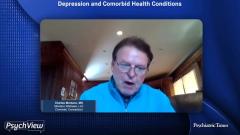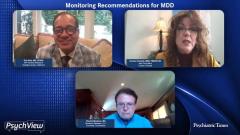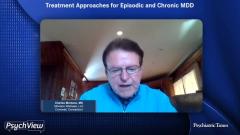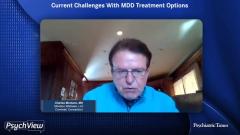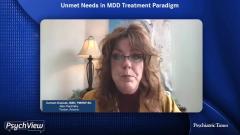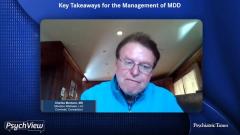
Unmet Needs in MDD Treatment Paradigm
Experts in psychiatry examine emerging agents and unmet needs for the management of MDD.
Episodes in this series

Gus Alva, MD, DFAPA: Charles, we’ve both had interplay in clinical research for over 27 years. How are some of the new treatment approaches—glutamatergic, GABAergic, psychedelics like MDMA—exciting that are coming up? How do you foresee these agents fitting into the treatment paradigm? Many individuals still see that there a lot of unmet needs in treating and managing major depressive disorder [MDD]. That’s because even though we have many options, we still have a lot of individuals who are ill. Give us your insight regarding what’s coming, what you’re excited about, and how you foresee these treatment approaches fitting within the paradigm of what we do.
Charles Montano, MD: We have a host of new targets that are not monoamine targets, and that’s very important. That’s in unipolar and bipolar [MDD]. The thing about bipolar that’s problematic is movement disorders. The Hippocratic oath says, “First, do no harm.” Every time we prescribe a drug that has potential lethal effect, we must think about that. We went from tricyclics to SSRIs [selective serotonin reuptake inhibitors] because of the lethality. They were good drugs, but they also hit so many targets that weren’t the right targets. Now we’re trying to refine and look at the targets. We’re looking at glutamate, GABA, and multiple other targets—we could make a list of them. That’s the new world, and that’s where we’re going.
When we look back 15 or 20 years from now, when these drugs are past clinical trial and are coming into play, they’re going to be cleaner and have fewer adverse events associated [with them]. They’re going to be very effective. Hopefully they’ll be the answer for the future, maybe even with artificial intelligence. We’ll be able to reach out to and treat more individuals with less lethal, more effective drugs if we can get the economics of it sorted out.
Gus Alva, MD, DFAPA: Maybe this is a little more provocative, but are you more excited about, say, zuranolone, Relmada, R-ketamine, or the Compass or psilocybin trials?
Charles Montano, MD: All of the above. How about psilocybin? How about working with therapy and doing effective therapy with that drug on board? My goodness. You’re resetting an awful lot of things. I look at gestalt bioenergetic, at the gestalt of how we are put together: our belief systems, our negative belief systems, the ones that are problematic for us. They may have saved our lives way back then, but not now. They’re interfering and using new ways of reprogramming ourselves. We’re almost like computers we can reprogram. Psychiatry may look quite different in the future, and hopefully primary care will as well.
Gus Alva, MD, DFAPA: That’s awesome. Carmen?
Carmen Kosicek, MSN, PMHNP-BC: A couple of different things that have come to mind during this conversation is that insurers and systems need to realize that, just like in primary care, what you hear the most is cost of the medication. We’ve consistently said that we’d need to look at total health care spending. If it takes the cost of the medication of the newer agent, then that’s by far more cost-effective than the whole picture. We see this with clawback rates upon discharge from hospitals and how frequently do they go back in. That clawback rate has been put into place for the hospitals to make sure they get quicker follow-ups, but it needs to be looked at on a much bigger scale. The recidivism rates are for not only inpatient but also outpatient. The economics of this truly needs to be put into play.
As a frontline provider, I’m excited about the agents I have. I’m excited that you all do research, but some of these are too far down the pike. My focus is mainly of what is here right now. Among many of our peers, the uptake is not there, even of the agents we have. It’s exciting. It’s an unknown about many of the psychedelics that are coming. It can be a little frightening, just the name of them.… It takes education to realize what we do or don’t know. I mainly focus on what we have now, what’s quickly coming, and treating the patient with those products. What’s our uptake of newer medications across [the United States]? How do we know they’re better? We don’t have head-to-head [studies]. We had the triptan class from 25 years ago with a head-to-head [study] of the first agent in the class vs the seventh, which most providers have never heard of.
I ask, “Is it the head-to-head [study], or is it that you can look at the adverse effect profile?” You can look at the half-lives, figure out when it needs to be dosed—the frequency or the duration. Isn’t that enough? Why must it be a head-to-head [study]? The risk is too great. Let’s get the medications on the market and learn how to use them because the patient could be you. That’s how I look at this. I’m very excited about things coming in research, but I want to ignite the fire within providers to learn how to get medications that are available. These are not fiscally unobtainable. I practice across 4 states, and Medicaid, Medicare, and commercial cash are always an issue. You can get these medications even for the cash patient. There’s patient assistance, but it takes learning the process. That’s all it takes. The fire needs to be lit for that provider to realize the changes they can make for that patient.
Gus Alva, MD, DFAPA: I love this discussion. We know that more than 300 million individuals worldwide suffer from major depressive disorder. Charles, you’ve touched on not only the emotional symptoms but also the physical and cognitive symptoms of this disease carries. Carmen, the prevalence of major depressive disorder varies from country to country, but in the United States, about 35 million individuals are affected, so there are a lot of unmet needs. This is not just from a tolerance issue, where individuals have a lot of GI [gastrointestinal] problems, insomnia, changes in body weight, sexual dysfunction, and emotional blunting. There are often persistent symptoms and partial responders.
That carries over to the theme of treatment-resistant depression. That’s another theme that we haven’t even touched on. How do individuals define treatment resistance? Is it more than 2 failures? Is it more than 4 failures? That’s another discussion, and I promise I’ll invite you both to be a part of that. But the main themes here are burden of disease, high morbidity, high mortality, that this is a leading cause of disability globally, and that it has a serious financial repercussion on many individuals.
TRANSCRIPT EDITED FOR CLARITY
Newsletter
Receive trusted psychiatric news, expert analysis, and clinical insights — subscribe today to support your practice and your patients.

